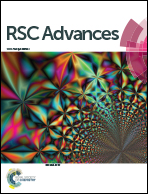Triple network hydrogels (TN gels) prepared by a one-pot, two-step method with high mechanical properties
Abstract
In this work, poly(vinyl alcohol) (PVA) was incorporated into the networks of polyacrylamide/polyacrylic acid (PAM/PAA) to prepare novel PAM/PAA/PVA Triple-network (TN) hydrogels by an in situ polymerization and repeated freezing–thawing (F–T) process. The TN hydrogels have not only high mechanical strength, but also a moderate swelling ability by varying the weight ratio of calcium chloride (CaCl2) and PVA and free shaping. The compressive stress of the as-prepared hydrogels could reach 11 MPa, and the highest stretching stress could reach 0.8 MPa. Upon mechanical loading, the coordination network between PAA and CaCl2 served as sacrificial bonds to efficiently dissipate energy. However, they can reform when the mechanical load is released, resulting from the fast coordination between PAA and Ca2+. Therefore, TN hydrogels have potential application in biomaterials.



 Please wait while we load your content...
Please wait while we load your content...